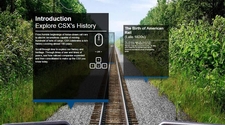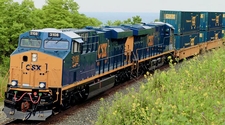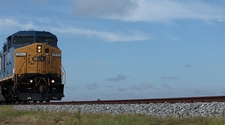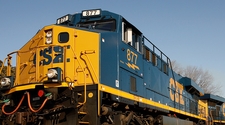| Magnetic Field |
A term applied to the space occupied by electric or magnetic lines of force. |
| Magnetic Flux |
The number of lines of magnetic force that pass through a magnetic circuit. |
| Main Iron (Slang) |
See Main Track. |
| Main Line |
That part of the railway, exclusive of switch tracks, branches, yards, and terminals. |
| Main Reservoirs |
The large reservoirs on a locomotive for storing the main supply of compressed air. |
| Main Track |
A track extending through yards and between stations. It is other than an auxiliary track. |
| Maintenance of Way Equipment |
Equipment designed for working on tracks and railroad right-of-ways. |
| Make a Joint |
To couple cars. |
| Make the Air |
Hook up the rubber air hoses and cut the air into them by turning the angle cock on the end of a car. |
| Make Whole |
The payment of 100% of lost wages. |
| Making a Hitch |
Coupling two cars together. |
| Making the Iron (Slang) |
The process of coupling two cars together. |
| Making the Joint (Slang) |
The process of coupling two cars together. |
| Manifest |
A description of the contents of a shipment. |
| Manifest Clerk |
Clerical yard office position which handles inbound and outbound movement of trains. |
| Manual Interlock |
A signal interlock operated by an employee by means of an interlocking machine, used to change railroad signals, a safety device to keep trains out of occupied areas. |
| Mark |
Process of underlining or writing information on a document or printout. OR An identifying mark on cotton shipments. OR Identifying marks on rail equipment. |
| Marked Capacity |
The load or carrying capacity of transportation equipment as marked or stenciled thereon. |
| Marker |
A device, such as a red flag or ETD that marks the end of a train. |
| Market Value |
Value of a product at destination. |
| Marking Off |
Reporting as not available for work. OR The act of completing an employee's time ticket, showing the time released from duty. |
| Marking Up |
The act of reporting availability for duty. |
| Mass Maintenance |
The process of updating a group of related data in a batch environment. |
| Mass Merge (ARZ) |
When one patron's name is changed to a name that is already in ARZ. |
| Master Tariff |
A tariff that is applicable to or governs a large number of tariffs. |
| Mate |
A cabless locomotive, which has traction motors and must be coupled to another locomotive, from which power is supplied. |
| Mated Trailer |
Accounting term which allows a customer to receive a more favorable shipping rate, when two trailers are being shipped to the same location, on the same bill of lading, or separate bills of lading cross referenced to one another. The two trailers may be on the same flat car or train, but it is not necessary to qualify for the rate. |
| Maximum Authorized Speed |
The highest speed permitted for any train on a subdivision or portion of a subdivision. It will be found listed under "Maximum Authorized Speed" in special instructions. |
| Maximum Continuous Amperage (MCA) |
The amperage at which a locomotive may operate continuously under heavy load conditions without damaging the traction motors. |
| Maximum Rate |
The highest rate that may be charged for a shipment. |
| Meat Rack (AKA Beef Rail) |
The supports near the ceiling of a reefer from which meat is suspended. |
| Mechanical Car |
See Refrigerator Car. |
| Mechanical Designation |
An alphabetic code assigned by the Association of American Railroads to every freight car to designate its general design characteristics and its intended purpose. Mechanical designations are stenciled on every car on the same line and immediately to the right of the capacity stenciling. |
| Mechanical Inspection |
Physical inspection of a car performed to determine its condition. |
| Mechanical Refrigerator Car |
A car equipped with a diesel powered refrigerating unit under thermostatic control. |
| Medium Speed |
A speed not exceeding 30 mph. |
| Memo Copy Bill of Lading |
The duplicate copy of a bill of lading. |
| Memo Waybill |
Memorandum waybill. A waybill used when the agent does not have sufficient information to determine the freight charges. It contains adequate information to enable yards to properly handle cars. It is sometimes used to move empties. A memo waybill is also used to handle company material. |
| Merchandise Car |
A car containing several less than carload shipments. |
| Meter |
A measuring instrument which indicates or records the value of the quantity under observation. |
| Microfiche |
4 x 6 plastic card which can contain 208 reduced pages of information. Microfiche is read with a special machine. |
| MIFRR |
See Multiple Independent Factor Revenue Requirement. |
| MIFTR |
See Multiple Independent Factor Through Rate. |
| Mileage Allowance |
An allowance based on distance made by railroads to owners of privately owned freight cars. |
| Mileage Cars |
Private line cars for use of which carrier pays a rate per mile. |
| Mileage Tariff |
A tariff of either agency or individual line's issue that contains tables of distances between stations or junctions. |
| Milepost |
A marker that identifies by number a given track location. It shows the number of miles from one point on the division to another point. |
| Milling in Transit |
Shipping grain, lumber, etc., to a point located between points of origin and destination, for the purpose of milling. |
| Mini Land-Bridge |
The movement of a shipment (which originates overseas) across the US via rail to its destination. |
| Minimum Carload Weight (AKA Minimum Weight) |
The least amount of weight for which the rate of a carload shipment will be calculated. |
| Minimum Charge |
The lowest charge for which a shipment will be handled. Unless otherwise specifically stated elsewhere, minimum charges for line haul transportation by rail are as published in Rule 13, UFC 6000. |
| Minimum Continuous Speed (MCS) |
The minimum speed at which a locomotive may operate continuously under heavy load conditions without damaging the traction motors. |
| Minimum Rate |
The lowest rate that will be used to calculate a freight charge. |
| Minimum Reduction |
An initial reduction of approximately 6-8 pounds in equalizing reservoir pressure, which in turn, reduces brake pipe pressure the same amount. This results in a light brake application on the train. |
| Minimum Weight |
The minimum weight applied to a shipment (usually LCL or LTL) on which the charges are based. |
| Misapplied Payment |
A payment applied to the wrong freight bill, perhaps because of erroneous or missing remittance advice. |
| Miscellaneous Bills |
A bill for miscellaneous charges. |
| Miscellaneous Charges |
Charges that are not purely related to freight revenue such as reweighing, switching, detention, demurrage, etc. They may apply to freight cars, trailers, or containers. |
| Misdelivery |
The delivery of property by a carrier to a party neither authorized by the owner nor by the person to whom the carrier is bound by contract to deliver it. |
| Mixed Carload |
A carload of different articles in a single consignment. |
| Mixed Carload Rate |
A rate applicable to a carload of mixed commodities. |
| Mixed Consist |
Operation of other than identical locomotive units in a single locomotive consist. |
| Mixed Train |
A freight train other than an intermodal or unit train. |
| Mother Locomotive |
A conventional locomotive that has the additional electrical apparatus necessary to deliver electric current to power a slug locomotive. |
| Motor Car |
A small, self-propelled rail car operated on the tracks by Engineering personnel. |
| Motor Common Carrier of Property (AKA Motor Carrier) |
Common transportation carrier whose service is dedicated to the transportation of goods over the road, usually by trucks. |
| Moveable Stanchion |
See Knock-Down Stanchion. |
| Mud Hop (Slang) |
A yard clerk. |
| Multi-Car Rates |
A rate for shipments moving in two or more cars from one origin to one destination. |
| Multi-Plant |
When more than one local patron code in the same city or state exists for a patron. |
| Multilevel Car |
A long flatcar designed with one or more deck levels in addition to the car?s main deck; used to haul new automobiles and trucks. |
| Multiple Car Shipment |
Shipment moving in two or more cars from one origin to one destination. |
| Multiple Independent Factor Revenue Requirements (MIFRR) |
These are the specifically stated amounts to be allowed the junction settlement carriers as their share of the freight revenues when there are no special agreements covering the division of freight revenues. Shown in dollars per car. |
| Multiple Independent Factor Through Rate (MIFTR) |
A through rate that is constructed from two or more specifically-stated revenue factors. The through rate changes only when a carrier in the route elects to increase or decrease its factor. |
| Multiple Load |
Two or more shipments loaded in the same car, but destined for different locations. |
| Multiple Unit Valve (MU) |
A valve in the locomotive cab used with 26L brake equipment for cutting in and cutting out the independent brake valve. |
| back to top |

















